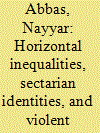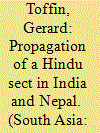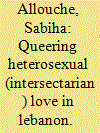| Srl | Item |
| 1 |
ID:
190090


|
|
|
|
|
| Summary/Abstract |
Sectarian-based violent extremism has long been a security concern for the Government of Pakistan. Despite the perseverance of state authorities in countering violent extremism, a discourse centered on horizontal inequalities as the determinant of violent extremism and conflict remains lacking. This paper highlights the importance of an empirical study in understanding the nexus between horizontal inequalities and sectarian-based violent extremism in Gilgit-Baltistan (GB). By analyzing the responses from Shia and Sunni sectarian identities, the study contextualizes violent conflict and elucidates how horizontal inequalities intersect with sectarian identities in the capital city of GB. In doing so, socioeconomic and cultural inequalities have been evaluated. The study relies on a multistage random sample of 212 respondents through a structured questionnaire. The findings reflect significant socioeconomic inequalities between the sectarian identities and suggest a linear relationship in which horizontal inequalities generate identity-driven “us” vs “them.”
|
|
|
|
|
|
|
|
|
|
|
|
|
|
|
|
| 2 |
ID:
103646


|
|
|
|
|
| Publication |
2011.
|
| Summary/Abstract |
The Krishna-PraCSAS_A_549082_O_XML_IMAGES/CSAS_A_549082_O_ILF0001.gifamacrmi-sampradamacry is a Hindu non-caste reformist sect belonging to the bhakti and sant streams. It originated in seventeenth-century Gujarat and rejects life-cycle rituals and sacrificial rites. Its expansion over the last decades in Nepal and Northeast India has been a remarkable phenomenon. This article examines the historical propagation of the congregation. In the past, the influence of charismatic religious figures prevailed; today, teaching by young preachers and the use of new means of communication, especially through mega-ceremonies of the pamacrramacryaCSAS_A_549082_O_XML_IMAGES/CSAS_A_549082_O_ILF0009.gif type, play a major role. This development has led to internal conflicts. A dissenting minority advocates a return to the original nirgun (formless, devoid of qualities) ideas of the group.
|
|
|
|
|
|
|
|
|
|
|
|
|
|
|
|
| 3 |
ID:
170053


|
|
|
|
|
| Summary/Abstract |
This article draws on a year of ethnography conducted among cis heterosexual couples in contemporary urban Lebanon in order to argue that, in the absence of a serious project of national reconciliation, intersectarian love, despite its short lifespan, constitutes restorative instances in post–civil war Lebanon. Intersectarian hetero desire emerges as a counter-discourse that threatens the masculinist foundations of the Lebanese state. By tracing the timeline of love in the life of Lebanese citizens, this article places personal narratives of “impossible” intersectarian love stories in conversation with queer temporality scholarship in order to recognize the political, albeit limited, potential of romantic love. Here, societal expectations of married life are replaced by an ephemeral unity that operates in contra to hegemonic interpretations of “man and wife.”
|
|
|
|
|
|
|
|
|
|
|
|
|
|
|
|
| 4 |
ID:
147719


|
|
|
|
|
| Summary/Abstract |
Boko Haram is an Islamic sect turned terrorist group. Despite its ethnic leaning, it is not a liberation front, and it does not advocate a people’s revolution. From an ideological point of view, it is a jihadist movement because it fights for full implementation of strict sharia law which would require a change of political regime and the establishment of an Islamic state. But it does not really follow the Wahhabi model of Al Qaeda or Daesh, unlike AQIM in Northern Mali or Al Shabaab in Somalia. In the region of Greater Borno, which encompasses parts of Nigeria, Chad, Niger, and Cameroon, the sect remains embedded in local dynamics which this article explores through an analysis of the mobilization of its members.
|
|
|
|
|
|
|
|
|
|
|
|
|
|
|
|